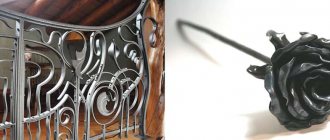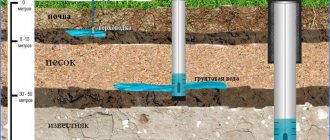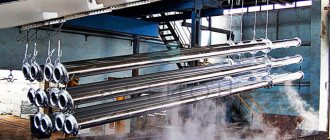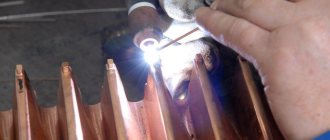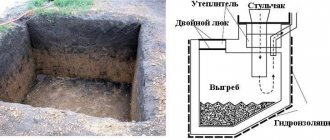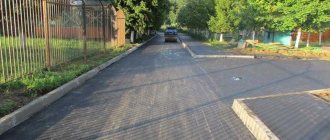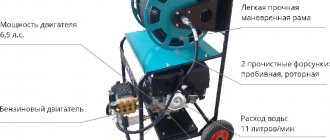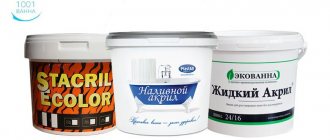About technological features
Classic hot laying of asphalt pavement involves working with material heated to a high temperature. The method shows excellent results with large volumes of construction, but in everyday conditions it is irrational and quite dangerous.
Working with cold asphalt looks completely different; The installation technology has been simplified, but if the conditions are met, this does not affect the quality. The composition for “cold” work is prepared according to a modernized scheme. The product is specially designed to produce high-quality asphalt pavement at minimal cost; it has the following composition:
- Mineral filler. Crushed stone, sand, gravel and mineral powder are mixed in different proportions.
- Organic astringent. Medium or slow thickening petroleum bitumen.
- Modifying additives (they may not exist). Additionally, the composition includes polymer components (plasticizers) with adhesive properties.
Cold asphalt before starting work Source mount-blade.ru
Modifying additives are mixed with bitumen and increase its ability to envelop the filler and create a characteristic homogeneous structure during storage. Plasticizers are especially effective if bitumen with high elasticity and fluidity is used. Manufacturers offer material of different fractions: 2-5 mm, 5-10 mm, 5-20 mm.
Hot asphalt concrete gains strength as the preheated material cools. In contrast, the cold analogue becomes stronger due to the evaporation of hydrocarbons (a component of plasticizers). When the cold mix of asphalt concrete is compacted, the polymerization process begins, resulting in a hard, ready-to-use surface.
Compacted cold asphalt continues to gain strength under load, while maintaining elasticity and ductility. Therefore, it does not collapse during temperature fluctuations, although it responds with expansion to an increase in temperature and compression to a decrease.
Structure of a layer of cold asphalt Source googleusercontent.com
Composition and types of asphalt concrete
Asphalt concrete is an artificial material obtained by rational selection of mixture components and its compaction after laying. Depending on the incoming components, the ratio of their mass parts and physical characteristics, there are many types of asphalt, divided into brands and types.
The composition of any asphalt concrete includes:
- mineral powders obtained by crushing rocks with a high content of carbon compounds (limestone or other fossilized organic deposits). The high content of such powders gives the material increased viscosity combined with strength. The property of such mixtures to dampen internal vibrations of structures without the formation of cracks in the coating allows the construction of road passages on road bridges. Successfully used for paving roads and sites
- bitumen, contained in most types in small quantities (from 4 to 5%). The exception is cast mixtures containing ≥ 10% bitumen. Bitumen gives the mixture increased fluidity, facilitating its distribution over the coating area, and elasticity after compaction and hardening. The main use of cast asphalt is paving of areas with complex terrain and repairing road surfaces. Increased bitumen content is used for asphalts laid in harsh climatic zones, at low temperatures and the need to open traffic immediately after the completion of a section of road or bridge crossing;
- sand is used in most types of asphalt concrete, the only exception being mixtures with a high gravel content. Natural sands are thoroughly cleaned, while artificial sands, obtained by crushing rocks, are immediately ready for use;
- crushed stone or gravel, which plays the role of a protective component that forms the asphalt concrete frame to absorb significant loads.
Based on the content of fillers, the following types are distinguished:
- A - from 50 to 60% crushed stone;
- B - 40...50% crushed stone or gravel;
- B - gravel or crushed stone from 30 to 40%;
- G - sand or screenings from crushing ≤ 30%;
- D - content of natural or artificial sands up to 70%.
Depending on the largest sizes of mineral grains in the mixture, they are divided into the following classes:
- coarse-grained first class - ≤ 40 mm. Used for paving highways with heavy traffic of heavy-duty vehicles and other highways of different classes;
- second class - with small grains ≤ 20 mm. Installed on pedestrian streets and squares;
- third - sand mixtures with grains ≤ 10 mm. Small fractions of grains are in close contact, which allows you to create perfectly smooth surfaces. The main purpose is pedestrian sidewalks, garden paths, improvement of courtyard areas and sports grounds.
Based on the percentage of the listed components, GOST 9128-2009 divides asphalt mixtures into three grades with a detailed description of the required compositions, technical characteristics and areas of use. It also provides recommendations for adding various additional additives to increase hydrophobicity, frost resistance, wear resistance and flexibility of coatings.
The second brand is most widely used in asphalting roads, their repair and arrangement of private courtyards with the construction of transport entrances.
Depending on the laying temperature, asphalt mixtures are divided into 2 types:
- Hot, laid with a temperature of ≥ 110 degrees. The hot mixture is transported by special transport, called Kocher, or in dump trucks with a heated body. If necessary, preparation for asphalting is carried out by softening the base under the influence of high temperatures. After leveling, the mixture is rolled with rollers. The resulting durable coating is most widely used in road work and landscaping of urban and suburban areas;
- Cold ones, which are placed with temperatures ≥ 5 degrees. When preparing, bitumen with a reduced viscosity is used, which allows the mixture to remain in a loose state for a longer time, and after rolling it hardens faster. Most often, such asphalt concrete is used for pothole repairs, laying on sidewalks and courtyard driveways that are not subject to intense loads.
Any high-quality asphalt concrete can only be made from certified materials, therefore, when ordering, you must require quality certificates and a passport for asphalt concrete.
Advantages of technology and material
Cold asphalt technology has become widespread due to the following advantages:
- Year-round use. You can lay asphalt in any season, as long as the air temperature does not go beyond the range from -15 to +40°C. For all-weather material, the only limiter is precipitation (but this is undesirable for most technologies).
- Quick readiness for use. The mixture hardens and acquires the stated characteristics in 15-20 minutes. You can almost immediately put the car on a brand new site.
- Zero waste. If there is a remainder of the mixture that is not used for installation, it can be applied elsewhere. The old coating can be removed (milled) and reused in the road construction industry.
- Possibility of long-term storage. Without containers, the mixture can be stored for up to 1 year. In polyethylene containers, the material retains its quality for up to two years.
- Safety. The technology was developed to be environmentally friendly; there are no hot processes. Adhesive plasticizers are inert substances that do not emit harmful volatile compounds.
Road patching Source inforum.com
- Easy transportation. Manufacturers package the mixture in buckets (25 kg each) or bags (50 kg each). A small truck or the trunk of a car is suitable for transportation.
- Mobility and high speed of work. The technology does not require additional operations, such as heating pits and processing edges in classic pothole repair; no need to use heavy equipment. All you need to do is clear the pits of debris. Thanks to the reduction in preparatory operations, work is carried out 1.5 times faster.
See also: Catalog of construction companies that have their own production of materials and components for the construction of houses
About landscaping
Any coating has its advantages and disadvantages. Asphalt is no exception. Its advantage can be considered the ability to use specialized equipment during the installation process. Note that building concrete, for example, is laid only by hand, which is incredibly difficult.
The main disadvantage of this artificial material is its strong odor. And all because the mixture contains bitumen, which under the influence of high temperatures begins to smell strongly. This causes some discomfort.
If we talk about asphalt paving, this process is quite complex. It requires strict adherence to technology. Please note that for each individual installation stage there are specific standards. If all the rules are followed, the finished coating will last for many years. It is also worth adding that a variety of techniques and equipment are used in the installation process. Therefore, it is not enough to simply attract experienced specialists and study the technology in detail. You also need to have a license confirming that the company has the right to provide the relevant services.
In addition, the contractor must know how to correctly calculate the thickness of the future coating, how to mark it, and carry out all the necessary work. He is also obliged to guarantee quality. This is very important, because each of us knows perfectly well how much domestic companies like to save on this process. As a result, the road surface crumbles in just one season.
Cons of the mixture
The technological accessibility and all-weather capability of the technology exceeds its following disadvantages by a margin:
- Due to the inclusion of plasticizers in the composition, the cost of the mixture (compared to traditional asphalt) is two to three times higher. The difference does not greatly affect the improvement budget; in private households, the technology is used to a limited extent.
- Water and dirt affect quality. If you choose to lay cold asphalt, be sure to thoroughly dry and clean the surface from dirt (especially important when laying it manually).
- A coating made from such a mixture does not withstand constant loads at high (summer) temperatures.
Asphalting the area in front of the gate Source grounde.ru
How to pave the yard with your own hands on a budget?
Mass construction of cottages and dachas is inextricably linked with landscaping. Of course, the primary task, upon completion of construction, is to improve the entrance and path to the house, since walking knee-deep in mud on a rainy day is far from an attractive prospect.
At the same time, laying tiles is a rather expensive and labor-intensive task, laying concrete is a relatively short-lived future, but laying asphalt, the price of which is much lower than paving slabs, is a rather attractive option, and the installation process is quite simple, so asphalting the area yourself will not cause any particular difficulties.
The main thing is to choose the right type of asphalt and follow the technology for laying it.
Advantages of asphalt pavement
Despite the relative environmental friendliness of asphalt mixtures, the demand for this material is unlikely to fade away, since the advantages of asphalt are superior to most similar materials in many respects, including:
- Excellent waterproofing;
- Does not deform during sudden temperature fluctuations;
- High degree of wear resistance;
- Moisture resistance;
- Resistance to oils, acids;
- Lack of labor-intensive care;
- Ease of repairing damaged areas;
- Duration of operation;
- Practicality;
- Reasonable price.
Among the disadvantages of asphalt mixtures, an unpleasant odor that appears in hot weather due to the release of toxic substances from a hot coating is of no small importance, although in most cases this nuance is simply omitted.
However, the manifestation of all the advantages of asphalt pavement is possible only if you have complete information on how to lay asphalt in the yard. Based on this, the initial task is to correctly select the type of asphalt relative to the conditions of its future operation.
Asphalt and its types
Asphalt is a combination of mineral materials with bitumen. Depending on the method of its production, asphalt is distinguished:
- Of natural origin. The formation of asphalt occurs under the influence of oxidation and hypergenesis of heavy oil fractions, or light components obtained from the remains of fractions during the evaporation process, followed by mixing with sand and gravel, forming quite thick layers on the surface. This type of asphalt is widely used in areas where oil comes to the surface.
- Artificial origin. Asphalt obtained by mixing sand, crushed stone, as well as mineral powder with bitumen in a factory is called asphalt concrete, through which the main asphalting of roads, sidewalks, etc. is carried out.
The main difference between natural asphalt and artificial asphalt concrete is due to the high content of bitumen in the composition of the mixtures, reaching 60-75%, which provides the laid asphalt with increased strength. In artificial asphalt, the percentage of bitumen varies from 13-60%, which explains its division into several subtypes used for various works and purposes.
Types of artificial asphalt, their characteristics
Recently, the demand for asphalt products has increased noticeably, so manufacturers are constantly striving to improve the technological composition of raw materials and the method of their production, which entails the emergence of new types of asphalt.
Today the following types of asphalt are produced:
1.Hot - made from a composition including sand, mineral powder, liquid or viscous bitumen, as well as crushed stone or gravel.
Under the influence of high temperatures, all components are thoroughly mixed, forming a homogeneous mass. In this case, asphalt laying is carried out immediately, within 4-5 hours from the moment of production of a certain volume.
If the temperature of the mass drops below 120 °C, the degree of adhesion will decrease, deteriorating the quality of the coating.
- High strength of the hardened coating;
- High degree of adhesion to the surface;
- Durability;
- Reasonable price.
- To compact the coating, it is necessary to use rollers and vibrating plates;
- Efficiency of work to avoid cooling of the asphalt mass;
- It can be used only after 5-6 hours;
- Ability to work in warm weather.
2. Cast asphalt, along with hot asphalt, has a similar composition, but differs in a higher content of bitumen and mineral fillers. The coating made of cast asphalt concrete differs from other types in its insignificant relief and small layer thickness, while the performance characteristics are several times higher than those of hot and cold asphalt.
- Excellent water resistance;
- No corrosion of the material;
- Resistance to various types of deformation;
- High degree of adhesion to the surface being coated;
- Compaction of the coating is not required;
- Resistance to temperature fluctuations;
- All-season work;
- Low mass due to the high density of the mixture;
- Durability.
- Use of special equipment for delivery and installation of the finished mixture;
- High price.
3. Colored – can refer to both hot asphalt and cold asphalt, produced by heating the components, followed by cooling and packaging for storage. Colored asphalt is obtained as a result of the use of colored crushed stone, as well as the introduction of colored dyes into the mixture.
- Excellent noise absorption;
- High adhesion to rubber;
- In the dark, the colored track is visible much better than the gray one;
- Durability.
However, due to its high cost, colored asphalt is used mainly for applying a contrasting pattern to the road and for marking paths in parks and gardens.
4. Cold - distinguished by the use of not viscous, but liquid bitumen or a bitumen emulsion in the composition in such a way that the constituent elements of the mixture are packed in a bitumen film. During production, special additives are introduced into the mixture to prevent hardening of the bitumen during storage of the finished mixture, as well as to increase the storage period.
- The polymerization process begins at the moment the coating is compacted;
- You can immediately move and drive on the laid asphalt;
- Resistance of the coating to expansion and shrinkage caused by weather conditions;
- Possibility of all-season work;
- Minimum content of harmful substances;
- Quick installation;
- Durability.
- Manual compaction of the coating is required, or using a roller;
- High cost compared to hot asphalt types.
5. Asphalt crumbs are recyclable materials obtained as a result of:
- Milling the outdated top layer of asphalt. The cost, along with the quality of the crumbs obtained in this way, directly depends on the composition of the asphalt mixture being processed and the speed of the cutter. Warm asphalt crumbs, consisting of a fine fraction, are considered to be of the highest quality. However, you can only purchase the material in the warm season, when repair work is carried out.
- Crushing pieces that have broken off from the asphalt surface. The crushing of chips entering production is carried out in a crusher, as a result of which the asphalt crumbs are immediately sorted by fraction size. During processing, bitumen remains in a frozen state, as a result of which the coating with such crumbs will have a somewhat loose structure. In addition, asphalt chips can come with stuck pieces of concrete and soil, deteriorating the quality of the processed material.
Thus, the quality and cost of asphalt chips after milling exceeds those of the material obtained through crushing.
In general, laying asphalt using crumbs is simple, resulting in the following advantages:
- Not washed away by water;
- Under the influence of the sun, bitumen liquefies, promoting sintering of the composition;
- Provides good drainage performance;
- Low cost.
- To give the coating strength, it is necessary to use a rolling device;
- Fragility.
Despite the variety of asphalt mixtures, the same type can have different purposes, depending on the size of the fractions included in it:
Areas of application
In addition to restorative pothole repairs on roads and parking lots, cold asphalt concrete is used in the following cases:
- Construction of a blind area in private housing construction.
- Construction of artificial ascents and descents.
- Framing road hatches, drainage grates and other metal elements on the canvas.
- Flat roof waterproofing.
- Filling potholes, cracks and expansion joints on the road.
- Laying garden paths and areas on private property.
Laying asphalt mixture around the hatch Source duna-spb.ru
Do-it-yourself installation instructions
The technologically unpretentious mixture has gained popularity among owners of private households. The use of the finished mixture is regulated by the rules of GOST 11-10-75. It is prohibited to be used on main roads (only for repairs), but it is permitted to be used for repairs or construction on personal property.
Cold asphalt adheres reliably to any surface (concrete, asphalt, brick, crushed stone). When developing a private territory, the asphalt concrete laying technology goes through the following stages:
- Preparation. The finished mixture is purchased in convenient packaging: bucket (30 kg), bag (25 kg), big bag (soft container, 1000 kg).
- At the site where the path is supposed to be, the fertile layer of soil (up to 10 cm) is removed. The excavation is filled with sand and gravel to half its height, and the layer is compacted. Using a gravel-sand mixture allows you to save on more expensive cold asphalt.
- If a site is being developed, geotextiles (density 300-400 g/m²) are laid on the leveled surface, which will prevent the upper layers from sagging. Crushed stone 15-20 cm thick is poured on top (a fraction of 2-20 mm is suitable). For compaction, it is better to use a vibrating plate or vibrating roller.
Laying cold asphalt with a manual roller Source kafmt.ru
- For the path, two layers of cold asphalt are laid (2-3 cm each). The layers are compacted with a hand roller.
- The site is also backfilled and compacted in layers. Tamping is considered complete when the vibrating plate stops leaving a mark. To prevent the material from sticking to the tool, use water.
- Completion. After compaction, the path is sprinkled with water and left for a day to gain strength. The edges of the site are coated with bitumen mastic (to preserve the geometry), the surface is covered with a cement-sand mixture. This measure will prevent asphalt from sticking to your car wheels and your shoes.
Water prevents the asphalt mixture from sticking Source thebalancesmb.com
Features of autumn and winter technology
When the temperature tends to zero and goes into minus, cold asphalt reduces plasticity, which can negatively affect the final quality. Therefore, it is recommended to prepare the material as follows:
- Before starting work, the bags of asphalt are kept in a heated room for at least two days. A temperature of at least +10°C will preserve the quality of the composition.
- Before use, cold asphalt is slightly loosened.
- The material itself and the installation site are heated (conveniently, for example, with a gas burner).
Asphalt path in front of the house Source na-dache.pro
What types exist
Currently, only two types of coatings are used:
- Asphalt.
- Tar.
Regarding the laying temperature, asphalt compositions are divided into two types:
- Hot type coatings. They are laid at temperatures above 140 degrees. This requires special equipment. Hot asphalt pavement is highly durable, so it is used for laying roads, city streets and squares.
- Cold asphalt. This type of mixture is also called warm, and it is prepared using bitumen, which has a reduced viscosity. Cold material is laid at a temperature of 80 to 120 degrees. Asphalt coatings of this kind are most often used in courtyards, playgrounds, sidewalks and other places that are not subject to heavy loads.
Briefly about the main thing
Cold asphalt successfully replaces its hot counterpart in garden plots and summer cottages. It consists of crushed stone and a specially selected bitumen-mineral binder, which helps the material quickly gain strength.
The characteristics of an asphalt mixture contribute to its success. It remains loose for a long time; this makes it easy to adjust its placement and compaction. It is important that you can work with the material at any time of the year; the composition is less demanding on base moisture than its hot counterpart.
Ratings 0
Compaction methods
The density of asphalt can be increased in several ways, which are selected based on economic indicators and benefits and the required volume of road work. Rolling involves rolling a metal drum or an air-inflated tire over the asphalt surface. Residual deformation in the layer during compaction tends to zero. The layer turns out strong and dense. The degree of compaction after rolling prevents additional compaction of the layer under the influence of moving vehicles. Rolling is carried out by special mechanisms - asphalt pavers. Vibration is the effect on asphalt of vibrations whose frequency coincides with its own. Vibrating machines are used.
The best result is achieved at the correct temperature, which is 60°C higher than the softening temperature of the binder used. The average temperature is 105–120°C.
